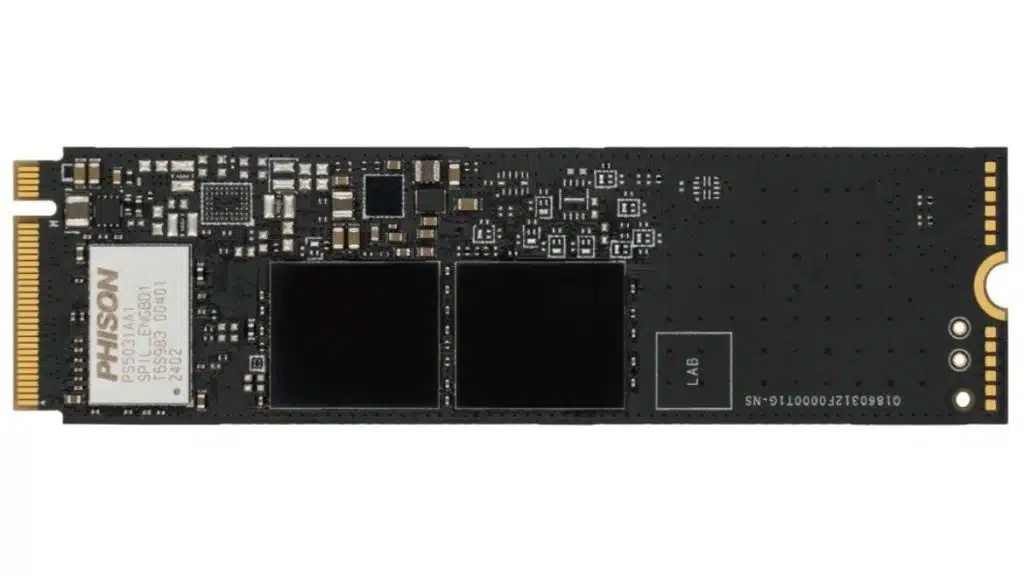
Early Phison PS5031-E31T DRAM-Less controller reviews reveal a PCIe Gen5x4 drive with impressive energy efficiency and read/write speeds. Phison first debuted its new controller aimed at bringing PCIe Gen5 performance to mobile devices while keeping power usage at a minimum last year. PCIe Gen5 NVMe drives have notably had much higher power draw and thus some have had to incorporate cooling measures similar to CPUs and GPUs with heatsinks, fans, and sometimes even liquid cooling. While read/write speeds for such drives may be reaching new epic levels many users are unlikely to commit to the added cooling needs to achieve them. The early Phison PS5031-E31T DRAM-Less controller reviews show potential, with compromises, that can provide the best of both worlds for platforms that support PCIe Gen5 drives.
The Phison PS5031-E31T controller uses an ARM Cortex R5 CPU built on a TSMC 7nm process to provide a more cost efficient approach by eliminating the need for DRAM. It can be used with drive capacities up to 8 TB and supports 3D TLC/QLC NAND in an M.2 2280 form factor. Sequential Read/Write speeds can reach up to 10,800 MB/s with 4K random read/write speeds up to 1,500K IOPS.
Phison PS5031-E31T Specifications
| Features | Specifications |
| Host Interface | PCIe 5.0 x4 (Bandwidth: 32GT/s x4) Backward compatible with existing PCIe generation transfer rates Compliance with PCI Express Base Specification Revision 3.1 Compliance with NVMe 2.0 Host Memory Buffer (HMB) support |
| Processor | Single-CPU architecture with built-in 32-bit microcontroller TSMC 7nm process technology |
| Flash Controller | Up to 4 Channels with 16 chip enable (CE) counts Flash transfer rate up to 3600MT/s Capacity up to 8TB Support 3D TLC and QLC NAND flash memory Compliance with Toggle 5.0 and ONFi 5.1 Flash I/O operating voltage supply 1.2V |
| Data Reliability | Phison 7th generation LDPC ECC & RAID ECC engine End-To-End Data Path Protection |
| Security | AES256 SHA384 SHA512 RSA4096 TCG OPAL 2.01 Pyrite 2.01 |
| Performance | Sequential Read up to 10,800MB/s Sequential Write up to 10,800MB/s 4K Random Read up to 1,500K IOPS 4K Random Write up to 1,500K IOPS |
| Power Management | ASPM + APST Supported |
| Temperature Range | Operating range: 0~70 °C Storage range: -40~85 °C |
| Package | 228-ball HSFCCSP, 8.0mm x 12.5mm |
| Peripheral | Built-in internal thermal sensor GPIO pins Built-in UART function I3C, I2C and SPI for external ROM Support of SMBus |
Currently, there are multiple reviews (1, 2, 3, 4), of early engineering samples that use 2TB Kioxia BiCS8 3D TLC NAND operating at 3600 MT/s. In terms of speeds, the drive has been seen more or less reaching its advertised speeds which while not beating the fastest Gen5 drives holds it above most Gen4 and at least towards the upper end of the Gen5 lists. It supports APSM (Active State Power Management) for optimal power efficiency and there is a significant drawback if this is not enabled. When active, ASPM can keep the idle power draw at 0.074W, an impressive feat only surpassed by a handful of other drives such as Samsung’s 970 EVO Plus and 980 series. When disabled, however, idle power draw does spike to over 2W putting it at the bottom of the list so clearly Phison has intended this drive to always operate with ASPM active. The Phison E31T controller shines though by taking the #1 spot for energy efficiency in read tests at 1,969 MB/s per watt beating nearest competitors Lexar NM790 at 1,727 MB/s and Kingston NV3 at 1,581 MB/s. The Samsung 990 Pro has a much lower read efficiency at 1,362 MB/s.
